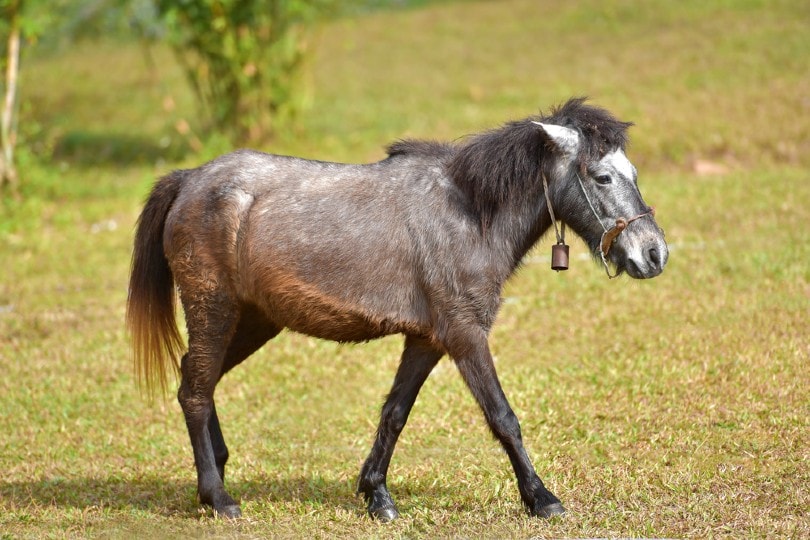
| Height: | 35–68 inches |
| Weight: | 300–800 pounds |
| Lifespan: | Around 30–40 years |
| Colors: | Sorrel, black, brown, bay |
| Suitable for: | Owners of small farms looking for a light-working animal |
| Temperament: | Calm, slow-moving, strong |
Hinnies are produced when you breed a horse stallion with a female donkey. They are less common than mules and tend to be slightly different from them. However, they have some broad similarities, making it difficult to tell mules and Hinnies apart.
Hinnies are typically utilized for farm work, as they are sturdy and easy to control. They are healthier than their parents, thanks to their mixed genes. Plus, they also have a very good immune system. Therefore, they are a great option for small farm owners.
These animals often have the same “shape” as a horse. The mane and tail of a hinny usually look more like a horse. However, as a mixed breed, there can be a lot of variances. Therefore, you never know what you’ll get until the animal is older. While these animals are usually calm and hardy, they have temperament differences.
Hinny Fouls
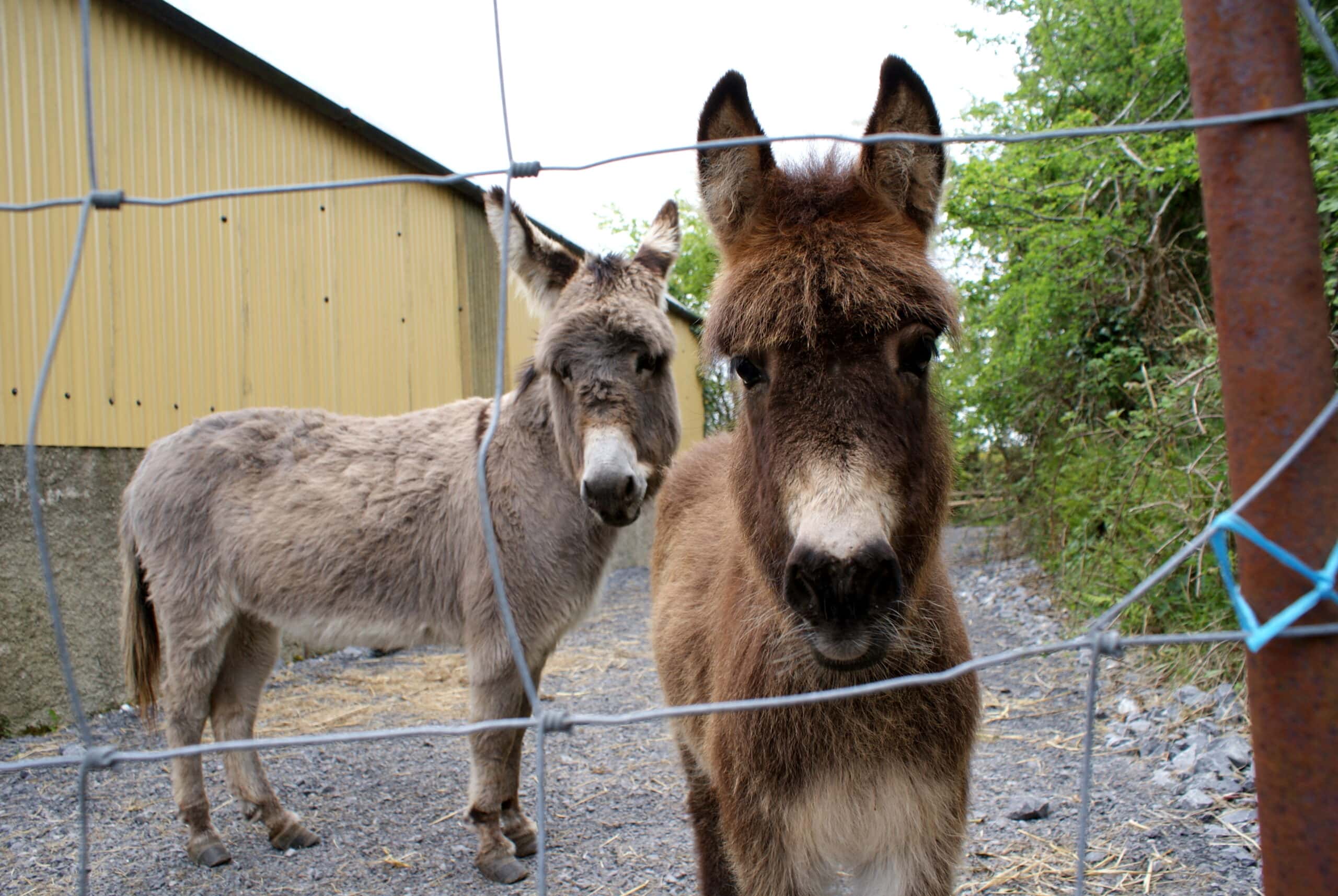
3 Little-Known Facts About the Hinny
1. Little is known about them.
While Hinnies have been around for a long time, there isn’t much actually known about them. There is much generally accepted information about them, such as that they have smaller ears than mules. However, the average breeder or farmer often has many mules and only one hinny. Therefore, their option is often based on limited experience.
There are very few farmers that have many Hinnies. This fact makes it challenging to draw conclusions about Hinnies as a whole. Those with a lot of Hinnies often describe them as being practically the same as mules.1
2. They vary a lot.
It’s common to hear opinions like “Hinnies are smaller than mules” and “Hinnies have less vigor.” However, these animals vary a lot based on their parents. No two Hinnies are the same. Overall, they seem extremely similar to mules, though they may have definite differences in their ear size. However, overall, there are very few certain differences that set all Hinnies apart from all mules.
3. Gestation time varies.
Gestation time varies a lot for Hinnies. It’s typically longer than a horse. However, it can vary from 11 months to 13 months, depending on the exact animal. Therefore, labor can sometimes be more challenging. However, again, it will depend on the mother.
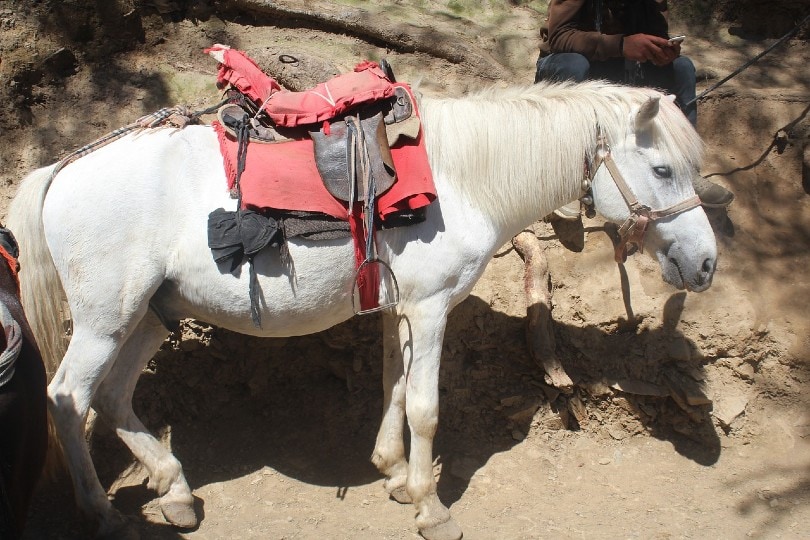
Temperament & Intelligence
Hinnies are extremely misunderstood. They are intelligent and have some unique temperament characteristics. Therefore, owners should research what to expect extensively before working with one of these animals.
There is a misconception that mules and Hinnies are stubborn. However, this isn’t necessarily true. They pick up on training concepts very easily, thanks to their high intelligence. When trained properly, they can be extremely well-behaved and a great worker. However, because of their intelligence, they can also tell when what you’re asking of them isn’t worth them doing it. They may try to get out of commands if you don’t have a strong relationship with your animal.
Therefore, it’s important to train them early and often. Rewards are important, and you should always maintain a solid relationship. Novice owners should avoid these animals due to their training complexities. Animals that become frightened during training may become easier to spook later on.
What Are Hinnies Good For?
These animals are often able to withstand tougher climates than horses. Therefore, they are often utilized to haul gear to remote areas where horses have a hard time. They are also less likely to run away and become spooked. Therefore, they are often utilized during wartime to carry ammunition and supplies.
They are extremely useful draught animals thanks to their endurance and health. In many regions, they are utilized heavily for farming and transportation.
Well-trained Hinnies can be ridden easily. Some even have sought-after gaits that cause the rider to feel little to no bumping while riding. They can jump very high—even from a standstill.
However, these animals do require significant training to accomplish any of this. They can make great companions for other equines, as they usually get along with others just fine. However, they can be potentially dangerous if mishandled.
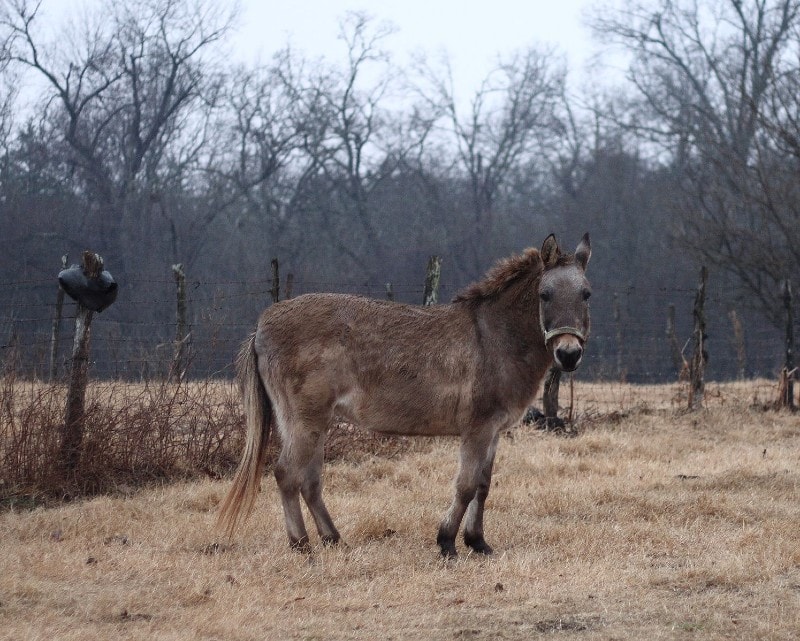
Things to Know When Owning a Hinny
Feeding & Diet Requirements
Hinnies are not small horses. They have special dietary needs that horses do not have. Therefore, they must be fed differently. These animals are particularly prone to obesity thanks to their high endurance and feeding should be regimented to prevent this.
You should always provide your hinny with high-quality straws. Barley and wheat are typically considered the best. Provide small amounts of hay or free grazing, as well. To ensure dietary needs are met, provide a vitamin or mineral supplement that does not promote weight gain.
Of course, you should always provide your animal with fresh, clean water.
To ensure health, have a professional check your hinny’s teeth once per year. You should also check your hinny for obesity yearly. Hinnies are prone to weight gain, which can cause various health issues.
If your hinny is overweight, restrict energy-rich foods like hay and grass. Ensure a fiber source like straw is always available to help keep your donkey full.
Avoid grain-based feeds. These may work for horses, but they are too calorie-dense for Hinnies. Also, try not to give unnecessary supplements. Your animal should only need a vitamin supplement, as instructed by your vet. Avoid sugary treats and licks as Hinnies are sensitive to sugar in a way that horses are not. Therefore, many treats and supplements designed for horses don’t work for these animals.
If your hinny is overweight, do not restrict food. Instead, lower carbohydrate consumption and raise fiber. Dieting can lead to hyperlipaemia, which can be fatal.
A diet of 75% straw in the summer and 50% straw in the winter is often suitable. However, you should adjust to suit your hinny’s specific needs.
Companionship
Hinnies require companionship to thrive. These animals are inherently social. Therefore, they must be kept in a herd of some sort. These animals may also have high territorial behaviors. They are sometimes used to defend smaller herd animals against predators.
Hinnies can technically be kept with just about any herd animal. They have a strong fight response, though, which can lead them into conflict with other animals. They prefer the company of animals most like themselves. Of course, this would preferably be other Hinnies, however, mules, donkeys, and horses also work.
Often Hinnies will pair bond with other Hinnies and/or mules. Sometimes, they will pair bond with other species. This would allow them to live next to other species without incident. However, Hinnies are very strong, and accidents can occur when they are kept with other animals.
Environmental Considerations
Hinnies need a decent amount of land to live on, including pasture for grazing. They also need to be kept in small groups, which increases the land required to house them. Therefore, getting a hinny often requires having a bit of land set aside for this purpose.
The minimum land requirement is half an acre per hinny. More land is always beneficial, though, as it gives the animal more space to move about. If you have enough land, you can divide it into different paddocks. Each area should be connected to the barn via a different gate. Open the gate for the particular paddock the animals should be grazing on each day during grazing time.
Having different paddocks helps the land recover from grazing, as you can adjust where the animals are allowed to graze. We recommend resting each paddock for at least 12 weeks, as this helps break the lifecycle of many parasites.
Fencing should be safe and contain Hinnies well. Electric fencing is often utilized. However, Hinnies are smart and will learn to tell when the fence is not on.
Remember, Hinnies cannot eat all plants. Some are toxic. Therefore, be sure their paddock only contains plants they can safely eat.
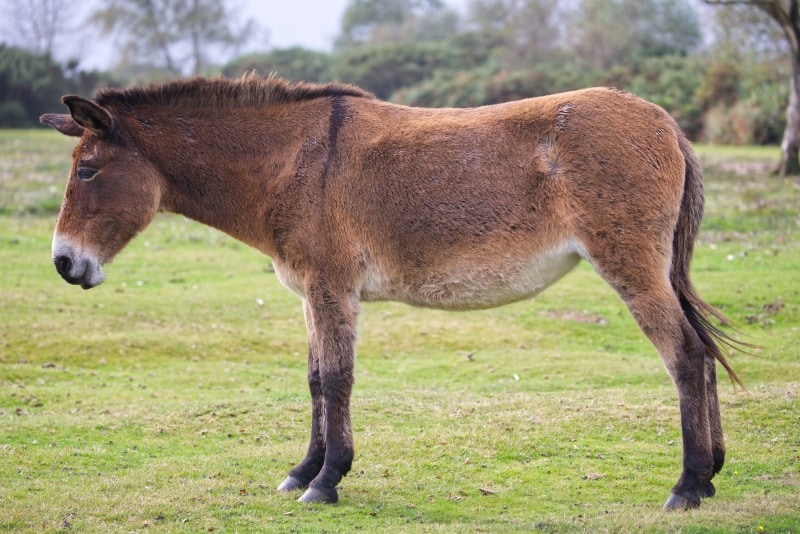
Enrichment
Hinnies also require a significant amount of enrichment. They are very intelligent animals and require regular mental challenges to stay happy and healthy. Otherwise, they can become bored, making them more difficult to handle. Plus, enrichment can also encourage exercise, which can reduce the odds of obesity.
Enrichment does not mean that your hinny will spend all day doing something. Instead, it simply provides more things for your dog to use. Good enrichment is a mix of making normal activities exciting (like eating) and new activities that are natural for Hinnies.
The first step to enrichment is to figure out what your donkey does all day. To do this, it can be helpful to create a sketch of the hinny’s environment, including where all the resources are. List all the things your hinny can currently do in the environment, such as eating, drinking, sleeping, and interacting with others.
Now that you know what your hinny is doing, you can expand their options.
Enrichment can occur in many ways. Simply moving things around can make the environment exciting. You can also provide toys, which should be changed regularly. Toys can range from safe logs to commercial-made balls. Be sure to refresh salt licks, branches, and other consumables. If an idea strikes, you can invent a new activity. For instance, you can place some carrots in a hollow log or put branches in a new location.
Enrichment should follow what a hinny does naturally in the environment. Often, this involves a lot of foraging behaviors. Therefore, most activities will involve food.
Health
The biggest health concern for Hinnies is obesity. In the wild, it would take a hinny all day to meet their caloric needs—and they would travel many miles. However, when domesticated, these animals can meet their needs in only a couple of hours of foraging (and without traveling much at all). Therefore, they can easily eat more than they need, leading to obesity.
The correct diet is vital for keeping these animals healthy.
You also have to consider their teeth, which can be worn down over time. Without healthy teeth, a hinny can have difficulty grazing properly (not to mention the potential for pain). Therefore, regular teeth checks are vital to combat any issues before they become serious. Certain dental issues are more common with age, so you may need to have older Hinnies checked more often.
Hyperlipaemia is common when owners attempt to combat obesity. Usually, this occurs when the hinny stops eating. When this happens, the body will attempt to use fat reserves as fuel. However, this can make too much fat appear in the blood, causing the liver and kidneys to degenerate. Even when spotted early, this disease is often deadly.
Serious Conditions: Hyperlipaemia, laminitis, respiratory disease, obesity, tetanus, colic, endocrine disorders
Minor Conditions: Lice, other parasites, dental issues
Conclusion
Hinnies are less popular than mules but experienced breeders often claim that the two breeds are extremely similar. There are not many differences, and the two are often indistinguishable. The only major difference that everyone can agree on seems to be a difference in ear size.
The most common misconceptions surrounding Hinnies likely come from their rarity, but they make a great companion for those living on small farms who have the space and need an animal to do some light work.
Featured Image Credit: Sirisak_baokaew, Shutterstock








